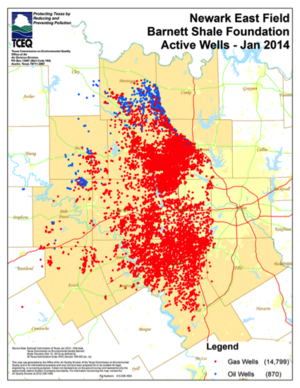Barnett shale play

The Barnett Shale gas play refers to an extensive gas development project covering portions of at least 18 counties1 in the northeast portion of the Bend arch Fort Worth Basin in Texas. Production occurs from organic rich shales of the Mississippian aged Barnett shale. The Newark East field is the field designation established by the Texas Railroad Commission for productive portions of the Barnett Shale Play area.
History
The Newark East field was discovered in 1981 by Mitchell Energy Corporation (acquired by Devon Energy). The development of the field started slowly, and only 100 wells were completed between 1981 and 1990. In 1998, a major breakthrough in completion techniques occurred when water fracturing replaced gel fracturing. From 1997 to 2006, more than 5829 wells were put on production, and hundreds of additional wells were drilled, completed, or waiting on a pipeline. Vertical wells were the primary drilling method until 2002 when seven experimental horizontal wells were drilled. The excellent success of these wells prompted many operators to move their drilling mode from vertical to horizontal. The early development of the fields (up until 2007), is outlined by Martineau3 in 2007.. Development activity continues today with over 14,000 active gas wells as of January 20145.
Barnett Shale
The Barnett Shale is an upper Mississippian aged organic rich shale. It serves as the reservoir, source and seal for the Newark East field. It is also the primary source for petroleum in the Fort Worth Basin, and has been the source rock of oil and gas for other conventional reservoir systems in the basin such as the Ellenburger, Strawn, and others. Jarvie Et Al, 2007, Montgomery, 2005, and Hill , 2007. Montgomery, et. Al, in 2005 published on the Barnet shale potential, and a Special Edition, of the AAPG Bulletin (April 2007), was dedicated to the Barnett shale and Newark East field.
Production
Gas production reached its highest level to date in 2012, with an average of 5,743 Million Cubic Feet (MMCF) of gas per day, during 2014 production averaged 4,920 MMCF/day. The field also produced oil and condensate at an average rate of 3,207 and 15,757 bbls/day respectively in 2014. Latest production statistics are available from the Texas Railroad Commission. 1
In 2013, Browning, et. al., reported on work underway with the Bureau of Economic Geology aimed at determining ultimate production for the Barnett Shale. At that time the Barnett had produced over 12.5 TCF of natural gas, with ultimate production in the range 45 TCF estimated.
Significance
As of 2009 the Barnett (Newark East field) was the largest gas field in the U.S. by proven reserves . However by 2015, in an update by the EIA , it was ranked number 2 having been surpassed, by another shale play, the Marcellus Shale in Pennsylvania and West Virginia. Perhaps more importantly however, the success of developing the Barnett Shale has opened the door for success not only the Marcellus but also in other gas plays in the United States such as the Woodford, Fayetteville and Haynesville and others.
References
- http://www.rrc.state.tx.us/oil-gas/major-oil-gas-formations/barnett-shale-information/
- Martineau, David F., 2007, History of the Newark East Field and Barnett Shale as a gas reservoir, AAPG Bulletin, v.91,No. 4, p.399-403.
- Pollastro, Richard M., Jarvie, Daniel M., Hill, Ronald J., Adams, Craig W., AAPG Bulletin,v.91, No.4, pgs. 405-436.
- Singh, Prema, Slatt, Roger, Coffey, William,2008, GCAGS transactions.
- Texas Texas Commission on Environmental Quality: http://www.tceq.state.tx.us/assets/public/implementation/barnett_shale/bs_images/bsOilGasWells.png
- John R. Browning , Svetlana Ikonnikova1 , Gurcan Gulen1 , Eric Potter1 , Ken Medlock1 , Frank Male1 , Susan Horvath1 , Tad Patzek1 , Qilong Fu1 , Forrest Roberts1 , and Scott Tinker, 2013, Barnett Gas Production Outlook, Search and Discovery Article #10541 .
- John Browning, Scott W. Tinker, Svetlana Ikonnikova, Gürcan Gülen, Eric Potter, Qilong Fu, Susan Horvath, Tad Patzek, Frank Male, William Fisher, Forrest Roberts, 2013, BARNETT SHALE MODEL-2 (Conclusion): Barnett study determines full-field reserves, production forecast: Oil &Gas Journal , and Sept. 2, 2013
- Scott L. Montgomery,1 Daniel M. Jarvie,2 Kent A. Bowker,3 Richard M. Pollastro, 2005, Mississippian Barnett Shale, Fort Worth basin, north-central Texas: Gas-shale play with multi–trillion cubic foot potential; AAPG Bulletin, V. 89, No. 2, P. 155-175.
- Energy Information Agency, 2009, Top 100 Oil and Gas Fields By 2009 Proved Reserves, http://www.eia.gov/oil_gas/rpd/topfields.pdf
- Energy Information Agency, 2015, Top US Oil and Gas Fields March 2015, http://www.eia.gov/naturalgas/crudeoilreserves/top100/pdf/top100.pdf